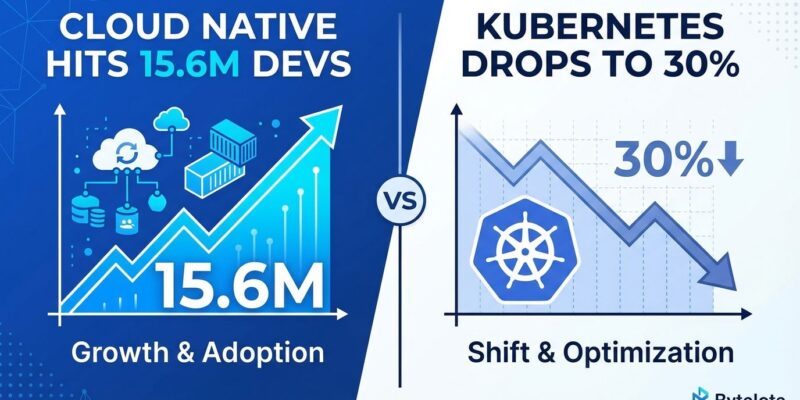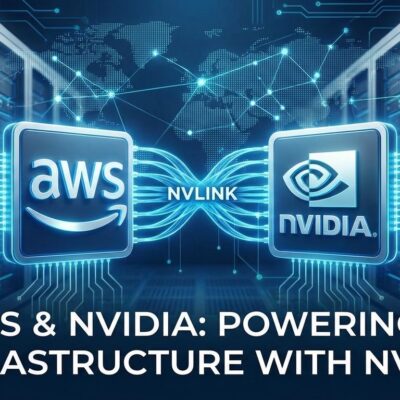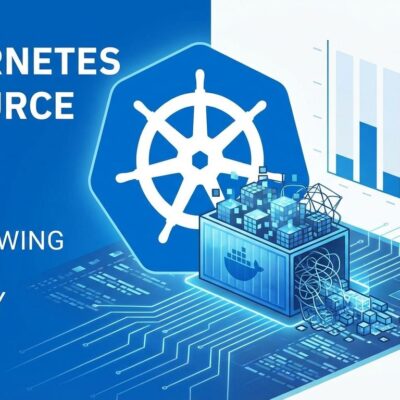
CNCF’s November 2025 State of Cloud Native Development report delivers a paradox: 15.6 million developers now use cloud native technologies, with 58% of backend developers fully onboard (up 9% since Q1). But Kubernetes adoption fell to 30% from its 36% peak in 2023. The ecosystem is booming while developers ditch the complexity king.
The Kubernetes Paradox
Container usage dropped to 52% from 60% in 2020. Kubernetes fell from 36% to 30%. Service mesh crashed from 18% to 8%. Meanwhile, Docker holds strong at 71.1% usage (Stack Overflow 2025), with IT industry adoption hitting 92%.
The math is clear: containers win, orchestration complexity loses. Cloud native doesn’t equal Kubernetes. According to industry analysis, 61% of organizations plan to shrink their Kubernetes footprint over the next 12 months. Only 42% of K8s applications reach production, and 75% of users face regular operational issues.
Kubernetes is powerful – it handles massive scale and powers huge infrastructures. But for most teams, it’s overkill. High resource usage, hidden costs, specialized DevOps requirements, and endless YAML tuning make it a hard sell when simpler alternatives exist.
Platform Engineering Eats Orchestration
While Kubernetes struggles, platform engineering rises. Internal Developer Portals hit 27% adoption (up from 23% in Q3 2024). 58% of DevOps professionals use cloud native tools, and 55% of organizations adopted platform engineering. Gartner predicts 80% of large software organizations will have platform teams by 2026, up from 45% in 2022.
Platform engineering treats internal platforms as products, with developers as customers. Instead of raw Kubernetes clusters, platform teams build curated workflows and clear abstractions.
Development teams juggle 7.4 tools on average. 75% of developers lose 6-15 hours weekly switching contexts. Only 3% trust their metadata quality. Platform engineering solves this by hiding complexity behind useful interfaces.
AI accelerates the shift. 52% of platform teams use AI for infrastructure tasks like provisioning and anomaly detection. 92% of CIOs plan AI implementations in 2025. It’s about shipping value, not managing YAML.
The Cloud Native Ecosystem Thrives
Despite Kubernetes declining, cloud native is healthier than ever. 15.6 million developers represent 77% of backend professionals using cloud native technologies. The CNCF report shows 9.3 million developers focused on backend services, with hybrid cloud usage up to 32% from 22% in 2021.
The AI angle: 7.1 million AI/ML developers (41% of AI professionals) use cloud native technologies. That’s massive growth potential. AI workloads need scalable infrastructure, and cloud native delivers. Chris Aniszczyk, CNCF CTO: “Cloud native is expanding far beyond traditional backend and container infrastructure use cases.”
Go Powers the Backbone
Over 75% of CNCF projects are written in Go: Terraform, Kubernetes, Docker, Prometheus. The language grew 25% year-over-year and ranks 62.7% in “most loved” surveys. 11% of developers plan to adopt Go in the next 12 months.
Go compiles to a single binary, has built-in concurrency, and balances performance with productivity. For infrastructure tools, it’s the default. Over 70% of Go developers use AI assistants regularly.
Simplicity Wins
You don’t need Kubernetes to be cloud native. Serverless platforms (AWS App Runner, Fly.io, OpenShift Serverless) and lightweight tools (Docker Compose, Podman, k3s) handle most use cases without the overhead. HashiCorp Nomad offers orchestration without K8s complexity.
The trend: “minimal, task-focused platforms” that let teams ship faster, spend less, scale smarter. 64% of developers use non-local environments as primary setups (up from 36% last year).
Gartner: 95%+ of new digital workloads will run on cloud-native platforms by 2025 (up from 30% in 2021). The container market hits $10.27B this year, $29.69B by 2030. Cloud native is the future – but not the Kubernetes-centric vision we’ve been sold.
Platform engineering eats orchestration. Developers want abstractions that work, not infrastructure to manage. The 15.6 million cloud native developers prove the ecosystem is growing, but declining Kubernetes numbers show the path: simplicity, developer experience, and platforms that hide complexity.
You don’t need Kubernetes to win. You need the right abstractions, the right tools, and focus on shipping value.












